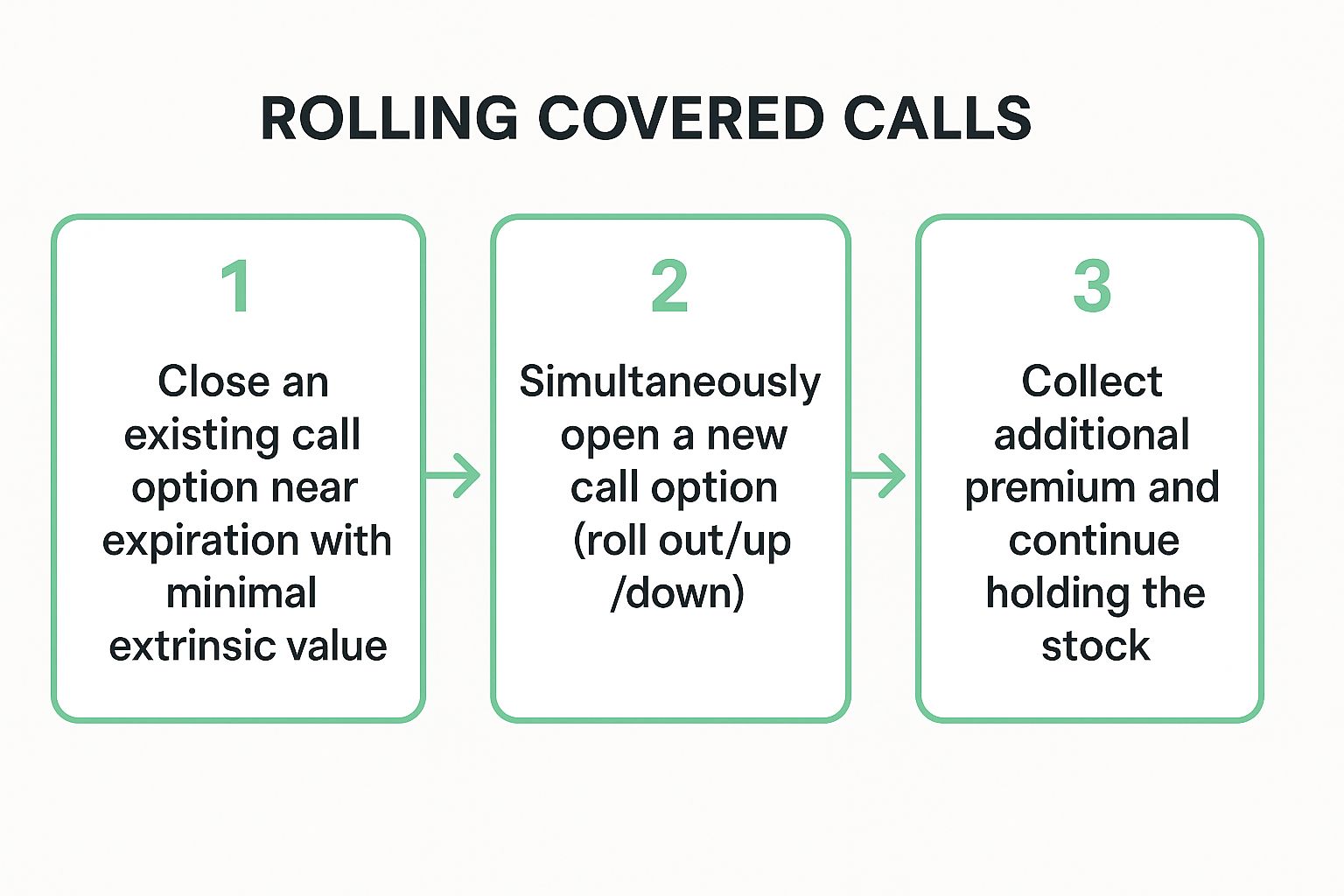6 Covered Calls Examples to Boost Your Income in 2025
If a stock moves past your strike, the option can be assigned — meaning you'll have to sell (in a call) or buy (in a put). Knowing the assignment probability ahead of time is key to managing risk.
Posted by
Related reading
A Trader's Guide to the Poor Man Covered Call
Discover the poor man covered call, a capital-efficient options strategy for generating income. Learn how to set it up, manage it, and avoid common mistakes.
A Trader's Guide to Shorting a Put Option
Discover the strategy of shorting a put option. Our guide explains the mechanics, risks, and rewards of cash-secured vs. naked puts with clear examples.
What Is Risk Adjusted Return? A Practical Guide
What is risk adjusted return? This guide explains how to measure it with the Sharpe Ratio, how to interpret the numbers, and why it's key to smarter investing.
Covered calls are a cornerstone strategy for generating consistent income from a stock portfolio, but moving from theory to real-world application can be daunting. Many investors understand the basics-owning 100 shares and selling a call option-but stumble when choosing the right strike price, expiration, or management tactic for different market conditions. This guide bridges that gap with practical, detailed analysis.
We will dissect six distinct, real-world covered calls examples, each tailored to a specific goal, from maximizing monthly cash flow to capturing dividends and leveraging capital efficiently. By exploring the detailed mechanics, strategic reasoning, and actionable takeaways behind each trade, you'll gain the confidence to implement this powerful strategy yourself. The focus is on turning your existing stock holdings into a reliable, income-generating machine.
This isn't just a list of successful trades; it's a playbook. You will see the "why" behind each decision, including how to select the optimal strike price to balance premium yield with your desired outcome. We will break down several scenarios, including at-the-money (ATM) calls for aggressive income, out-of-the-money (OTM) calls for a balance of growth and income, and advanced techniques like rolling positions and dividend capture. Each example provides a clear, replicable framework for your own portfolio.
1. Basic At-The-Money (ATM) Covered Call
The at-the-money (ATM) covered call is the foundational strategy for income-focused investors. It involves owning at least 100 shares of a stock and selling a call option with a strike price that is very close to the current market price of the underlying shares. This approach offers a compelling balance, providing substantial upfront premium income while leaving a small amount of room for potential capital gains if the stock price rises modestly.

This strategy is ideal for neutral to slightly bullish market outlooks where you don't expect significant price swings. By selling an ATM call, you are essentially agreeing to sell your shares at or near their current value in exchange for the highest possible premium compared to out-of-the-money options.
Trade Example: Apple Inc. (AAPL)
Let's look at one of the most common covered calls examples using a popular tech stock.
- Entry Position: You own 100 shares of AAPL, purchased at $172 per share.
- Market Price: AAPL is currently trading at $175.10 per share.
- Action: You sell one AAPL call contract with a $175 strike price that expires in 30 days.
- Premium Collected: You receive a premium of $3.50 per share, which totals $350 ($3.50 x 100 shares).
This transaction immediately generates a 2.0% cash return on your stock holding ($350 premium / $17,500 stock value).
Potential Outcomes at Expiration
- Stock Finishes Below $175: The call option expires worthless. You keep the full $350 premium and your 100 shares of AAPL, free to sell another call.
- Stock Finishes Above $175: The call option is exercised. Your 100 shares are automatically sold at the strike price of $175 each. Your total profit includes the $350 premium plus the $300 capital gain from your original purchase price ($175 sale price - $172 cost basis), for a total gain of $650.
Strategic Takeaways
- Maximize Premium: ATM calls offer the highest extrinsic value, making them excellent for maximizing immediate income.
- When to Use: This strategy shines when you believe a stock will trade sideways or slightly up. It's less ideal if you anticipate a major breakout, as your upside is capped.
- Risk Management: The primary risk is the stock price falling significantly. The premium collected provides a small buffer, effectively lowering your cost basis on the shares for that trade cycle.
2. Out-of-The-Money (OTM) Covered Call
The out-of-the-money (OTM) covered call is a more growth-oriented strategy favored by investors who are bullish on their underlying stock but still want to generate income. It involves selling a call option with a strike price that is significantly higher than the stock's current market price. This approach offers less premium income compared to ATM calls but provides substantial room for the stock to appreciate in value before the shares are called away.

This strategy is ideal for moderately bullish to very bullish outlooks. By selling an OTM call, you collect a smaller premium but retain more of the potential upside, making it a powerful way to enhance returns on a stock you believe will continue to rise.
Trade Example: Tesla, Inc. (TSLA)
Let's break down one of the most popular OTM covered calls examples with a high-growth stock.
- Entry Position: You own 100 shares of TSLA, purchased at an average cost of $225 per share.
- Market Price: TSLA is currently trading at $240 per share.
- Action: You sell one TSLA call contract with a $260 strike price (8.3% OTM) that expires in 45 days.
- Premium Collected: You receive a premium of $8.20 per share, which totals $820 ($8.20 x 100 shares).
This transaction immediately generates a 3.4% cash return on your stock holding ($820 premium / $24,000 stock value) while allowing for another $20 per share in capital appreciation.
Potential Outcomes at Expiration
- Stock Finishes Below $260: The call option expires worthless. You keep the full $820 premium and your 100 shares of TSLA, ready to sell a new call for the next cycle. Your breakeven price is lowered to $216.80 ($225 cost basis - $8.20 premium).
- Stock Finishes Above $260: The call option is exercised. Your 100 shares are sold at the $260 strike price. Your total profit is the $820 premium plus a $3,500 capital gain ($260 sale price - $225 cost basis), for a combined gain of $4,320.
Strategic Takeaways
- Balance Growth and Income: OTM calls allow you to participate in a stock's upward movement while still collecting premium. This is perfect for holdings you want to keep long-term.
- When to Use: Employ this strategy in bull markets or on stocks you have a strong conviction will appreciate. Selecting a strike price above a known technical resistance level can be a sound tactic.
- Lower Assignment Risk: OTM options have a lower delta (e.g., 0.30 or less), meaning a lower probability of being exercised. This gives you a higher chance of retaining your shares and continuing to sell calls against them.
3. LEAPS Covered Call (Poor Man's Covered Call)
The LEAPS covered call, often called the "Poor Man's Covered Call" (PMCC), is a capital-efficient strategy that mimics the income generation of a traditional covered call without requiring the upfront cost of owning 100 shares. Instead, an investor buys a long-term, deep-in-the-money call option (a LEAPS) and then sells shorter-term call options against it. This approach dramatically reduces capital outlay while offering a similar risk-reward profile.
This strategy is ideal for investors who are bullish on a stock long-term but want to generate regular income without tying up significant capital. It leverages the lower cost of the LEAPS option to achieve a much higher return on investment (ROI) compared to using shares.
Trade Example: SPDR S&P 500 ETF (SPY)
Let's explore one of the most popular covered calls examples using a LEAPS contract on a broad market ETF.
- Entry Position: Instead of buying 100 shares of SPY at $450 ($45,000 cost), you buy one deep-in-the-money LEAPS call option with over a year until expiration. Let's say you buy a SPY call with a $400 strike price for a premium of $60.00 per share.
- Total Capital Deployed: Your total investment is $6,000 ($60.00 premium x 100 shares), a fraction of the cost to own the shares outright.
- Action: With SPY trading at $450, you sell one monthly call contract with a $460 strike price that expires in 30 days.
- Premium Collected: You receive a premium of $3.00 per share, which totals $300 ($3.00 x 100 shares).
This single transaction generates an immediate 5% cash return on your LEAPS investment ($300 premium / $6,000 cost).
Potential Outcomes at Expiration
- SPY Finishes Below $460: The short call expires worthless. You keep the $300 premium and your LEAPS contract, allowing you to sell another short-term call next month.
- SPY Finishes Above $460: The short call is exercised. You can either close both positions for a profit or roll the short call up and out to a future date to continue the strategy. The profit is the difference between the strike prices ($460 - $400) minus the net cost of the LEAPS ($60.00) plus the premium received ($3.00), for a total of $300 per share.
Strategic Takeaways
- Capital Efficiency: The primary benefit is leverage. You can control a position equivalent to 100 shares for significantly less capital, freeing up funds for other investments.
- When to Use: This is perfect for long-term bullish outlooks on high-priced stocks where owning 100 shares is prohibitive. Choose LEAPS with a high delta (above 0.80) to ensure they move closely with the underlying stock.
- Risk Management: Your maximum loss is limited to the premium paid for the LEAPS contract. Always ensure the strike price of the short call you sell is higher than your breakeven point on the LEAPS purchase.
4. Dividend Capture Covered Call
The dividend capture covered call is a sophisticated strategy designed to generate multiple income streams from a single position. This tactic involves buying a dividend-paying stock just before its ex-dividend date to "capture" the upcoming dividend payment, while simultaneously selling a covered call option against the shares to collect premium income. This approach aims to create three potential profit sources: the option premium, the dividend payment, and any capital gains if the stock appreciates.

This strategy is ideal for income-focused investors who want to compound their returns by actively managing their positions around dividend schedules. It combines the core benefit of covered calls (premium income) with the reliable cash flow of dividends, making it a powerful tool for enhancing yield, especially in a flat or slightly bullish market.
Trade Example: AT&T Inc. (T)
Let's break down one of the most practical covered calls examples using a well-known dividend stock.
- Entry Position: You purchase 500 shares of AT&T (T) at $18.00 per share just before the ex-dividend date.
- Market Price: T is currently trading at $18.10 per share. The company has announced a quarterly dividend of $0.2775 per share.
- Action: You sell five T call contracts with a $19 strike price that expire in 45 days.
- Premium Collected: You receive a premium of $0.40 per share, which totals $200 ($0.40 x 500 shares).
By holding the shares through the ex-dividend date, you are also entitled to the dividend payment of $0.2775 per share, totaling $138.75 ($0.2775 x 500 shares).
Potential Outcomes at Expiration
- Stock Finishes Below $19: The call options expire worthless. You keep the full $200 premium, the $138.75 dividend payment, and your 500 shares of T. Your total immediate income is $338.75.
- Stock Finishes Above $19: The call options are exercised. Your 500 shares are sold at the strike price of $19 each. Your total profit includes the $200 premium, the $138.75 dividend, and the $500 capital gain ($1 per share), for a total gain of $838.75.
Strategic Takeaways
- Compound Income Streams: This strategy effectively stacks income from premiums and dividends, significantly boosting the total return on your investment over a short period.
- When to Use: It works best with stable, high-yield stocks like Dividend Aristocrats or REITs around their ex-dividend dates. It is crucial that the option's expiration date is after the ex-dividend date. To dive deeper into the mechanics, you can learn more about the Dividend Capture Covered Call strategy and its nuances.
- Risk Management: A primary risk is early assignment, where the call buyer exercises the option just before the ex-dividend date to capture the dividend themselves. To mitigate this, sell calls with a strike price where the extrinsic value is greater than the dividend payment, making early exercise less likely.
5. Rolling Covered Calls Strategy
The rolling covered call is an active management technique that transforms the basic strategy into a continuous income stream. Instead of letting a call expire or having shares assigned, the investor closes the existing option and simultaneously opens a new one with a later expiration date. This "roll" allows you to adjust the strike price up, down, or keep it the same, all while collecting more premium.
This dynamic approach is perfect for investors who want to hold their underlying stock long-term but wish to adapt to changing market conditions. By rolling, you can avoid assignment on a stock you want to keep, lock in profits, or reposition your strike price after a significant price move, making it one of the most versatile covered calls examples.
Trade Example: NVIDIA Corp. (NVDA)
Let's explore how rolling works to manage a position on a volatile but bullish stock.
- Initial Position: You own 100 shares of NVDA.
- Original Trade: You sold a call with a $120 strike price when the stock was trading at $122. It is now two weeks before expiration, and NVDA has risen to $130. Your call is deep in-the-money, and assignment is likely.
- Action (Rolling Out and Up): You execute a single transaction to "buy to close" your current $120 call and "sell to open" a new call with a $135 strike price that expires next month.
- Premium Collected: This rolling action results in a net credit of $2.50 per share, or $250 total.
You have successfully avoided assignment, collected an additional $250 in premium, and given your NVDA shares more room to appreciate up to the new $135 strike price.
Potential Outcomes at New Expiration
- Stock Finishes Below $135: The new call expires worthless. You keep the $250 premium from the roll and your 100 shares of NVDA, ready to sell another call. You have now collected premium twice on this position.
- Stock Finishes Above $135: Your shares are sold at $135 each. You keep the premium from the original sale plus the $250 premium from the roll, realizing a larger capital gain than if you were assigned at the original $120 strike.
This infographic outlines the simple, repeatable process for rolling your covered call positions.

The diagram shows a clear three-step cycle: close the existing option, open a new one further out in time, and collect a net credit, which enhances your overall return.
Strategic Takeaways
- Maintain Ownership: Rolling is the primary tool for investors who want to generate income without losing a long-term stock position.
- When to Use: Roll your position when an option is in-the-money and you want to avoid assignment, or when an out-of-the-money option is near expiration and you want to collect more premium. Typically, this is evaluated within the last 21 days of the contract's life. To dive deeper into the mechanics, you can learn more about the Rolling Covered Calls Strategy and its nuances.
- Risk Management: Always aim for a net credit when rolling. Rolling down to a lower strike price after a stock falls can help you continue generating premium, but it also lowers your upside potential if the stock recovers.
6. Covered Call Writing on Index ETFs
For investors seeking a more conservative and diversified approach, writing covered calls on broad market index ETFs is a premier strategy. Instead of tying your income generation to the fortunes of a single company, this method involves owning shares of an ETF like the SPDR S&P 500 ETF (SPY) or Invesco QQQ Trust (QQQ) and selling call options against that position. This approach significantly reduces single-stock risk and provides consistent income from highly liquid underlying assets.
This strategy is perfect for long-term investors who want general market exposure but also wish to enhance their returns with a steady stream of options premium. Because index ETFs are less volatile than individual stocks, the premium collected is often lower, but the predictability and reduced risk make it a cornerstone for many retirement and income-focused portfolios.
Trade Example: SPDR S&P 500 ETF (SPY)
Let's explore one of the most common covered calls examples using the S&P 500 index ETF.
- Entry Position: You own 1,000 shares of SPY, with a cost basis of $450 per share.
- Market Price: SPY is currently trading at $452.15 per share.
- Action: You sell ten SPY call contracts with a $455 strike price that expires in 30 days.
- Premium Collected: You receive a premium of $3.00 per share, which totals $3,000 ($3.00 x 100 shares x 10 contracts).
This transaction immediately generates a 0.66% cash return on your stock holding ($3,000 premium / $452,150 stock value) for the month.
Potential Outcomes at Expiration
- Stock Finishes Below $455: The call options expire worthless. You keep the entire $3,000 premium and your 1,000 shares of SPY. You are now free to sell another round of calls for the next expiration cycle.
- Stock Finishes Above $455: The call options are exercised. Your 1,000 shares are sold at the strike price of $455 each. Your total profit includes the $3,000 premium plus a $5,000 capital gain from your original purchase price ($455 sale price - $450 cost basis), for a total gain of $8,000.
Strategic Takeaways
- Diversification and Lower Risk: By using an index ETF, you eliminate the risk of a single company's poor earnings report or negative news event cratering your position. Your investment is spread across hundreds of companies.
- When to Use: This is an ideal core strategy for retirement accounts (like an IRA) where tax-deferred growth can compound premium income. It works best for investors with a neutral to bullish long-term market outlook who prioritize consistent income over maximum capital appreciation. For a deeper dive, learn more about covered call writing on index ETFs.
- Capital Efficiency: The high liquidity and tight bid-ask spreads of major index ETFs like SPY and QQQ mean you can enter and exit trades efficiently, without significant slippage. The sheer volume of options contracts also provides flexibility in strike price and expiration date selection.
6 Covered Call Strategies Comparison
| Strategy | Implementation Complexity 🔄 | Resource Requirements ⚡ | Expected Outcomes 📊 | Ideal Use Cases 💡 | Key Advantages ⭐ |
|---|---|---|---|---|---|
| Basic At-The-Money (ATM) Covered Call | Low to Moderate; straightforward and beginner-friendly | Moderate; requires owning 100 shares per contract | Generates 1-3% monthly income; balances income & modest appreciation | Income investors expecting neutral to slightly bullish markets | High premium income; immediate downside protection; consistent income |
| Out-of-The-Money (OTM) Covered Call | Low; conservative with simple strike selection | Moderate; owning shares required | Lower premium (0.5-2%), higher capital appreciation potential | Bullish investors wanting upside exposure plus income | Preserves upside potential; lower assignment risk |
| LEAPS Covered Call (Poor Man's Covered Call) | High; complex, requires options knowledge | Low capital (20-40% of traditional buy-in) | Similar income to traditional calls; higher return on capital | Experienced traders with limited capital seeking leverage | Much lower capital needed; defined max loss; flexible |
| Dividend Capture Covered Call | Moderate; requires careful timing around dividends | Moderate; stock ownership needed | 2-4%+ monthly total return combining dividends & premiums | Income investors focused on dividend-paying stocks | Triple income streams; dividend buffers downside risk |
| Rolling Covered Calls Strategy | High; active management with frequent monitoring | Moderate; requires continuous options trading | Continuous income generation; prevents assignment | Active traders wanting to maintain shares while generating income | Flexibility to adjust strikes; extra premium per roll |
| Covered Call Writing on Index ETFs | Low to Moderate; simple, but requires large shares | High; purchasing many ETF shares for diversification | Lower premium (0.5-1%), steady income with diversification | Conservative investors & retirement accounts | Diversification; high liquidity; reduced single-stock risk |
Choosing Your Strategy and Executing with Precision
Throughout this guide, we have journeyed through a spectrum of covered calls examples, each demonstrating a unique approach to generating income from your stock portfolio. From the straightforward At-The-Money (ATM) call for maximum immediate premium to the strategic Out-of-The-Money (OTM) call designed to balance income with potential capital gains, the versatility of this strategy is its greatest strength. We also explored advanced techniques like the capital-efficient LEAPS strategy and the dividend capture play, proving that covered calls can be tailored to fit nearly any market outlook or investor goal.
The key lesson from these real-world scenarios is that success is not accidental. It is the direct result of aligning your tactical execution with a clear, overarching strategy. Your choice of strike price, expiration date, and even the underlying asset itself should be a deliberate decision rooted in your financial objectives.
Core Takeaways from Our Examples
To truly master this strategy, it's essential to internalize the core principles demonstrated in each example. Let’s distill them down to actionable insights:
- Define Your Goal First: Are you aiming for maximum monthly income, long-term share appreciation, or a defensive hedge? Your answer dictates whether an ATM, OTM, or another variation is the right tool for the job. An income-focused investor might prefer the higher premiums of near-the-money strikes, while a long-term bull on a stock will lean towards OTM strikes to avoid having shares called away.
- Probabilities are Your Guide: Don't rely on guesswork. Using metrics like delta (as a proxy for the probability of expiring in-the-money) transforms your decision-making from a gamble into a calculated risk. This analytical approach, as seen in our examples, allows you to consistently place trades that align with your risk tolerance.
- Active Management is Non-Negotiable: The "set it and forget it" approach rarely works. As we saw with the rolling strategy example, market conditions change. Being prepared to roll a position up and out, or close it early to lock in profits, is what separates novice sellers from seasoned professionals. This requires a robust framework for evaluating good vs. bad risk in real-time.
From Theory to Profitable Action
The covered calls examples we've analyzed are more than just historical trades; they are blueprints for your own portfolio. The next step is to move from understanding these concepts to applying them with precision and confidence. This transition requires a commitment to a data-driven process. Instead of being swayed by market noise or emotion, focus on the numbers: the premium received, the probability of assignment, and the annualized return on your investment.
By consistently applying these principles, you can transform a simple stock holding into a dynamic, income-generating machine. You’re not just passively waiting for appreciation; you are actively extracting value from your assets, month after month. This disciplined approach is the cornerstone of building a resilient and profitable options trading portfolio.
Ready to apply these strategies with data-driven precision? Strike Price provides the real-time probability metrics and smart alerts you need to identify high-yield opportunities and manage your positions like a pro. Stop guessing and start executing with the analytical power demonstrated in these covered calls examples by visiting Strike Price today.